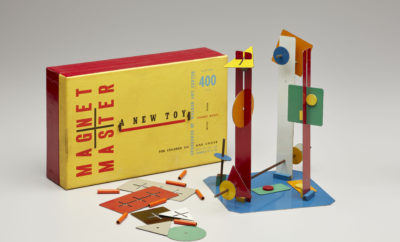 Installation view © 2014 Elizabeth Felicella Photography
Installation view © 2014 Elizabeth Felicella Photography
Exhibition
A Museum in Tennessee Looks at Life’s Cycle
KNOXVILLE DREAMS BIG
Knoxville is located in the center of the Great Valley in eastern Tennessee, nestled in the foothills of the Great Smoky Mountains. The city’s location at the headwaters of the Tennessee River and its railroad connections made it a prize fought for during the Civil War. It soon became the epicenter of the region’s economy and cultural history. In the last ten years, the population has nearly doubled, and the city seems determined to continue to thrive.
In 1990 renowned museum architect Edward Larrabee Barnes designed the four-story steel and concrete Knoxville Museum of Art (KMA) overlooking the site of the 1982 World’s Fair in downtown Knoxville. The reductive cube building clad in locally quarried pink marble serves as a foundation to contextualize the area’s rich cultural legacy and promote regional artists. On the occasion of its twenty-fifth anniversary, internationally acclaimed glass artist Richard Jolley was commissioned by long-time KMA supporters Ann and Steve Bailey to create a monumental permanent installation. Jolley was given complete artistic freedom to develop the ideas and imagery for the installation. The work took over five years to create, three months to install, and cost more than $1 million.
Cycle of Life: Within the Power of Dreams and the Wonder of Infinity spans the entire length of the KMA’s Great Hall (more than one hundred feet) and is one of the largest glass and steel sculptures in the world. Weighing more than seven tons, this tour de force required massive reinforcement of the building’s steel structure and the installation of new lighting controls to illuminate it. The piece is an epic seven-part narrative portraying the progression of life. “I looked at old black- and-white films with painted backgrounds and the actor in the foreground to grasp the idea of filling the frame or space,” Jolley says, adding, “I felt this space demanded monumental scale—I have seen ten by ten foot paintings on the wall, and they floated like small postage stamps so I knew scale was critical.” “Cycle of Life is a game-changer for the museum— it reveals Richard’s exceptional artistic rigor and vision—an aesthetically stunning masterwork that is also an engineering marvel,” says KMA director David Butler.
The first six stages, three representing youth on one side and three representing maturity on the other, flank a stair- case to the mezzanine; the seventh phase, “Sky,” hangs from the ceiling. Suggestive of the unknown and likened to both the structure of DNA and the cosmos, it represents the future.
There is no denying that the future looks bright for the city of Knoxville—certainly there seem to be nothing but blue skies ahead. knoxart.org
WHILE YOU’RE IN TOWN:
The McClung Museum of Natural History and Culture in Knoxville has collections and exhibitions in anthropology, archaeology, geology, natural history, and decorative arts. The Tennessee Theatre, which opened in 1928 as a grand movie palace with Spanish-Moorish designs by the once- famous Chicago firm of Graven and Mayger, was restored in 2005 and is now the city’s leading performance arts center. Legend has it that Ironwood Studios, a former bus repair depot turned studio was an old moonshine distill- ery. Metal artist Preston Farabow and woodworker John McGilvray established Ironwood in 2006. Farabows has built a name for himself with the NASCAR trophies he crafts on-site from metal parts thrown off by the cars during a race. mcclungmuseum.utk.edu tennesseetheatre.com












